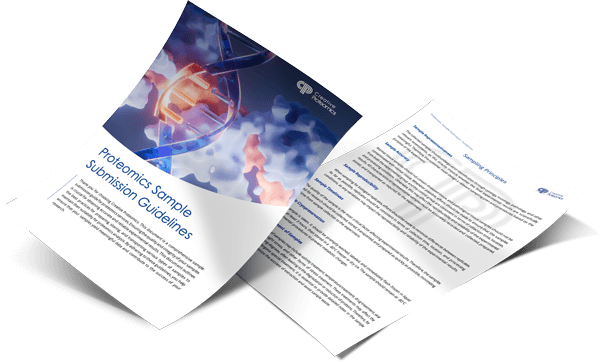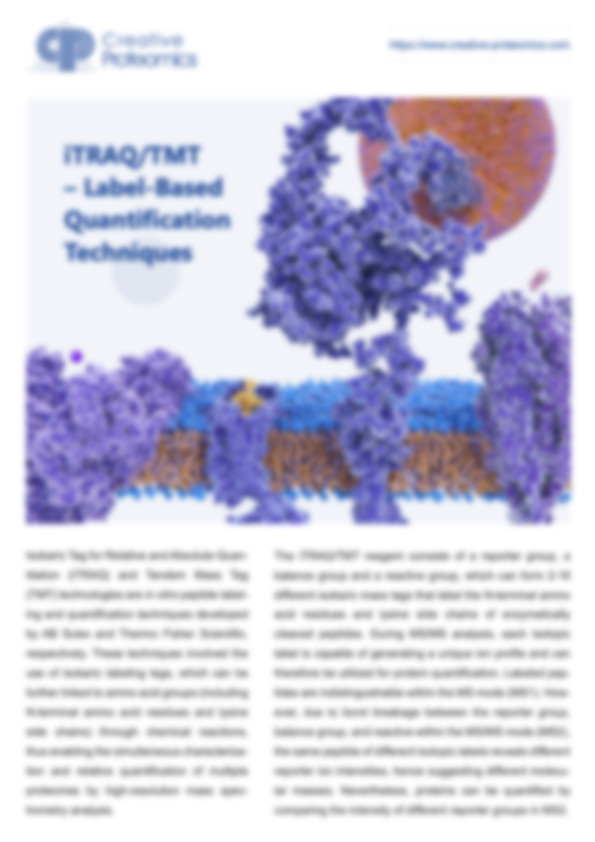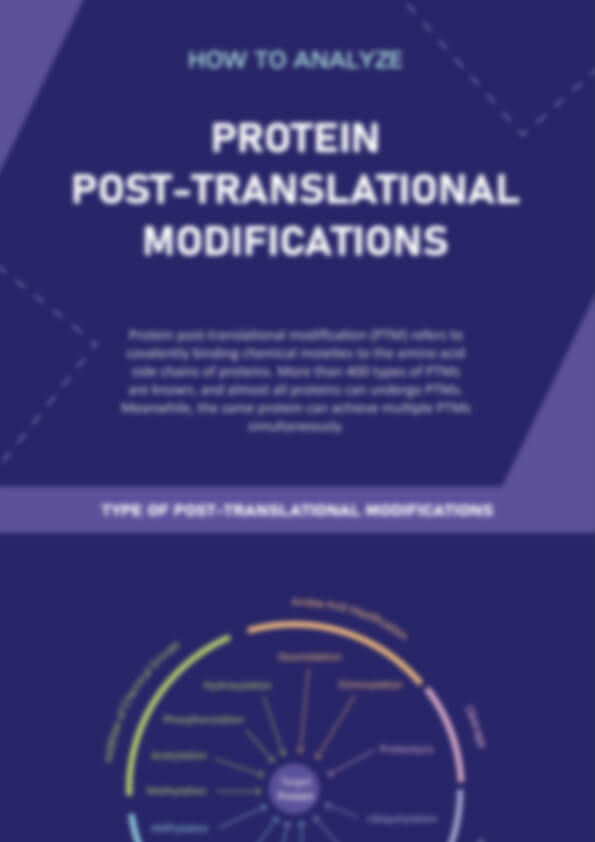Comprehensive Succinylation Analysis Service
At Creative Proteomics, we simplify complex protein analysis. Our succinylation analysis service is designed for research teams and drug developers who want high-resolution insights—without the in-house hassle.
Just send us your biological sample. Our team will take care of the rest—delivering reliable, publication-ready results tailored to your project goals.
By combining mass spectrometry with advanced peptide enrichment workflows, we support large-scale studies into metabolic regulation, disease progression, or post-translational control—all backed by the precision you need for confident decision-making.
- Precisely identify lysine succinylation sites
- Quantify modification changes across conditions
- Link metabolic pathways to epigenetic or disease-related functions
- Ideal for cancer metabolism, histone studies, and drug response profiling
Submit Your Request Now
×
This service is ideal for:
- Biopharma teams exploring protein modification patterns
- CRO clients needing site-specific PTM data
- Researchers investigating histone regulation or mitochondrial activity
- What is
- Technical Challenges
- Service Details
- Multi-Omics Integration
- FAQ
- DEMO
- Publication
What Is Succinylation and Why Does It Matter?
Lysine succinylation is a post-translational modification where a succinyl group—typically donated by succinyl-CoA—is attached to a lysine residue. This process can occur enzymatically or without enzyme involvement. Unlike many other protein modifications, succinylation is remarkably widespread, occurring in both prokaryotic and eukaryotic cells.
Recent proteomic studies have mapped thousands of succinylation sites across diverse organisms, including bacteria, fungi, parasites, and mammalian systems. These modified proteins are not restricted to a single location; they appear across cellular compartments—from membranes and the cytoplasm to the nucleus and organelles.
Unlike more transient PTMs such as phosphorylation or acetylation, succinylation can cause longer-lasting conformational changes, influencing protein stability, activity, and interaction networks.
Why does succinylation matter to researchers?
Because it regulates a wide array of metabolic processes, such as:
In essence, lysine succinylation acts as a molecular switch, influencing energy production and cellular activity. Understanding its distribution and function offers critical insights into metabolic regulation and cellular health metrics across species.
Key Roles of Succinylation in Cellular and Disease Contexts
Succinylation is far more than a biochemical curiosity—it is a regulatory mechanism with direct implications in disease progression, metabolic control, and drug response. As a reversible PTM closely tied to intracellular succinyl-CoA levels, succinylation is tightly regulated by metabolic state and cellular stress.
Recent studies have shown that:
- Histone succinylation alters chromatin accessibility, impacting gene expression programs linked to inflammation and cancer.
- Mitochondrial enzymes involved in the TCA cycle and oxidative phosphorylation are frequently succinylated, directly influencing energy metabolism.
- Succinylation is dynamically regulated by enzymes such as SIRT5, making it a candidate for targeted therapeutic modulation.
For researchers and pharma teams, accurately profiling succinylation is crucial to:
- Identify metabolic reprogramming in tumor and immune cells
- Uncover biomarkers in metabolic disorders or cancer
- Evaluate epigenetic impacts of histone-targeting drug candidates
Because succinylation often overlaps with acetylation or malonylation at the same lysine sites, non-specific detection methods can lead to misleading conclusions. Our high-specificity service—powered by validated succinylation antibodies and ultra-sensitive LC-MS/MS—ensures that you uncover the true biological signal with confidence.
Whether you're pursuing biomarker discovery, target validation, or mechanistic studies, our succinylation analysis platform delivers actionable insights that accelerate your research or development program.
Technical Challenges in Succinylation Detection
Despite its growing importance, succinylation remains one of the most technically challenging PTMs to analyze. Many research teams struggle with:
- Low stoichiometry — Succinylation often affects only a small proportion of total protein, making detection difficult without prior enrichment.
- Site overlap with other PTMs — Lysine residues can also be acetylated, malonylated, or ubiquitinated, leading to cross-reactivity in non-specific assays.
- Limited availability of high-specificity antibodies — Commercial anti-succinyl lysine antibodies vary greatly in performance, especially for low-abundance targets.
- Data complexity — Raw MS data for succinylated peptides often requires advanced bioinformatics pipelines for confident site localization and quantitation.
These challenges often translate to false negatives, misidentified sites, or incomplete pathway insights—especially in clinical or drug discovery settings where data accuracy is critical.
This is where our specialized Succinylation Analysis Service provides unique value:
✅ Validated anti-succinyl lysine antibodies with low cross-reactivity
✅ Optimized immunoprecipitation protocols to enrich low-abundance modifications
✅ High-resolution LC-MS/MS platforms for confident site-level detection
✅ Bioinformatics pipelines tailored to succinylation-specific identification and quantification
End-to-End Succinylation Analysis Service
At Creative Proteomics, we offer a streamlined, fully integrated workflow for succinylation profiling—tailored to meet the needs of biomedical research teams, CRO partners, and drug development pipelines.
Our process combines validated antibody enrichment, high-resolution mass spectrometry, and expert-level data interpretation to ensure you receive accurate, actionable results.
Service Workflow Overview
Antibody enrichment ensures targeted capture of succinylated peptides with minimal non-specific binding
Mass spectrometry is performed on Orbitrap or Q-TOF platforms for high accuracy and reproducibility
Bioinformatics analysis includes site localization, fold change calculation, and statistical significance
Reporting includes raw MS files, site tables, annotated spectra, and optional visual summaries (e.g., volcano plots, heatmaps)

Customized Bioinformatics Services
| Standard Analysis | Customized Analysis |
|---|---|
| a) Collection of output statistics b) Establishment of database and search for modified proteins c) Identification of modified proteins and modification sites d) Annotation of modified proteins e) Quantitative analysis of modified proteins f) Analysis of differential expression of modified proteins g) Functional enrichment analysis of differentially modified proteins GO/KEGG | Modified peptide motif analysis Protein network interaction prediction Protein domain prediction (Advanced Analysis) Protein subcellular localization analysis (Advanced Analysis) |
High-Quality Reagents and Succinylation Antibodies
Accurate succinylation profiling starts with one critical component: reliable, high-specificity antibodies.
At Creative Proteomics, we exclusively use validated anti-succinyl lysine antibodies that demonstrate:
✅ High affinity for succinylated lysine without cross-reactivity to acetylated or malonylated sites
✅ Proven performance in both immunoprecipitation (IP) and Western blot workflows
✅ Compatibility with histones, metabolic enzymes, and other succinylation-prone proteins
These reagents are extensively benchmarked across species (human, mouse, rat) and tissue types, ensuring reproducible enrichment even in complex biological samples such as tumor tissues or primary cells.
Our enrichment protocol has been optimized to work with as little as 100 µg of protein, making it ideal for low-abundance targets or precious clinical samples.
The result: high signal-to-noise ratios, confident site identification, and minimal sample loss—giving your project a strong analytical foundation from the very first step.
Applications Across Research and Drug Development



Academic & Basic Research
Epigenetics & Chromatin Remodeling
→ Quantify histone succinylation patterns that influence transcriptional control in development, immune regulation, and stem cell biology.
Mitochondrial Biology & Energy Metabolism
→ Identify succinylation-driven modulation of key enzymes in the TCA cycle and oxidative phosphorylation pathways.
Systems Biology & Proteome Dynamics
→ Integrate succinylation data into multi-PTM maps to better understand cellular response to nutrient shifts or stress.
Pharmaceutical R&D
Biomarker Discovery
→ Detect differential succinylation signatures in disease models (e.g., cancer, neurodegeneration, metabolic syndromes).
Mechanism-of-Action Studies
→ Investigate how therapeutic compounds affect succinylation status, especially when targeting sirtuin enzymes like SIRT5.
Epigenetic Drug Development
→ Characterize off-target effects of HDAC or sirtuin modulators on non-histone succinylation substrates.
CRO and Translational Research
Preclinical Model Validation
→ Profile succinylation in animal models to support drug efficacy, PK/PD, or toxicity readouts.
Custom Study Support
→ Our service platform is ideal for integrating into GLP-like workflows and CRO-sponsored projects requiring quantitative, site-specific PTM data.
Sample Requirements
| Sample Type | Minimum Amount Required | Notes |
|---|---|---|
| Fresh Animal Tissue | ≥ 600 mg | Snap-freeze in liquid nitrogen and store at −80°C |
| Fresh Plant Tissue | ≥ 6 g | Remove fibrous materials and clean before freezing |
| Cell Culture | ≥ 1 × 10⁷ cells/tube × 3 tubes | Adherent/suspension cells both acceptable; avoid serum contamination |
| Fungi and Bacteria | ≥ 600 mg | Pellet and freeze-dry for stability if long-term storage needed |
| Serum or Plasma | 450 μL × 4 tubes | Store in polypropylene tubes; avoid repeated freeze-thaw |
| Protein Solution | 5–10 mg total protein | Concentration ≥1 μg/μL preferred; provide buffer composition |
| Urine | 15 mL × 4 tubes | Centrifuge at 1000 × g for 5 min; discard pellet |
| Other Body Fluids | >15 mL | Includes saliva, amniotic fluid, CSF, etc.; please clarify matrix |
Shipping Conditions:
- Ship on dry ice
- Label clearly with sample name, species, and experimental group
- Include protein quantification info if available
What You'll Receive
We provide a comprehensive, publication-ready data package, including:
- Identified succinylation sites (with peptide sequence, site position, and protein ID)
- Quantitative comparisons across groups (fold change, intensity, P-value)
- Bioinformatics summary (volcano plots, heatmaps, site distribution)
- Raw MS data + processed results files (e.g., MaxQuant, Spectronaut format)
- Custom interpretation based on your study context (upon request)
Optional Add-On: Multi-Omics Integration
For complex metabolic or signaling studies, we offer integrated analysis pipelines combining succinylation with:
Global metabolomics profiling – to correlate succinylation changes with metabolite flux
Transcriptomics or proteomics – to map PTM regulation to upstream gene expression or pathway activation
Custom PTM panels – e.g., combine succinylation with acetylation or phosphorylation for systems-level insights
This is particularly useful in tumor metabolism, immunometabolism, and sirtuin-targeted drug studies.
Why Choose Creative Proteomics for Succinylation Profiling?
Deep Expertise in PTM Analysis
With over a decade of proteomics experience, our team specializes in low-abundance PTM detection—including succinylation, acetylation, phosphorylation, and methylation. We understand the unique biochemical behavior of lysine modifications and design workflows accordingly.
From histone succinylation in epigenetic studies to mitochondrial regulation in cancer, we've supported hundreds of PTM-driven projects worldwide.
Analytical Precision You Can Trust
- High-resolution LC-MS/MS (Orbitrap/Q-TOF)
- Ultra-specific anti-succinyl lysine antibody enrichment
- Site-level resolution with quantifiable fold-change data
- In-house QC standards for sample processing and MS calibration
End-to-End Flexibility, From Discovery to Application
Whether you're screening novel drug targets or validating metabolic biomarkers, we tailor our service to meet your biological goals and timeline. Custom study designs, co-analysis with transcriptomics or metabolomics, and regulatory consultation are available upon request.
Dedicated Scientific Support
Every project is guided by a dedicated PhD-level scientist, from experimental design through data delivery. We don't just provide raw output—we help you interpret the findings in context.
Frequently Asked Questions (FAQ)
Can succinylation analysis be combined with other PTM or omics profiling?
Absolutely. We offer integrated multi-omics solutions where succinylation profiling can be combined with:
- Phosphorylation, acetylation, or ubiquitination analysis in the same sample set
- Untargeted or targeted metabolomics to explore succinyl-CoA dynamics
- Transcriptomics or proteomics for pathway-level integration
This is ideal for studies in metabolic rewiring, drug mechanism of action, and epigenetic regulation.
Can I submit samples from non-model organisms (e.g., zebrafish, plant, or microbial strains)?
Yes. While most clients use human or mouse samples, we can process non-model species as long as:
- You provide a reference protein database (FASTA format preferred), or
- We work with de novo sequencing approaches for novel organisms
Custom bioinformatics workflows are available to support these cases.
How do you support hypothesis-driven projects or custom biological questions?
Beyond standardized analysis, our scientists can:
- Filter PTMs based on specific proteins/pathways of interest
- Perform comparative analysis across treatment groups or timepoints
- Deliver biological insight reports that go beyond raw data—summarizing key functional impacts
Do you provide assistance with publication or presentation formatting?
Yes. For academic or pharma clients preparing manuscripts, we can:
- Format result tables and figures per journal requirements
- Provide annotated spectra or site maps suitable for supplementary data
- Supply methodology descriptions aligned with peer-reviewed standards
Is your platform suitable for preclinical or exploratory biomarker projects?
Definitely. Many of our clients use succinylation data to:
- Identify early-stage disease signatures
- Validate drug target engagement
- Map off-target PTM effects in candidate therapies
We also offer batch-to-batch reproducibility studies and long-term project support for CRO partners.
Learn about other Q&A.
DEMO

Publication
Here are some publications in PTMs Proteomics research from our clients:

- Trypanosoma cruzi DNA Polymerase β Is Phosphorylated In Vivo and In Vitro by Protein Kinase C (PKC) and Casein Kinase 2 (CK2). Cells (2022). DOI: https://doi.org/10.3390/cells11223693
- Synergistic Combined-proteomics Guided Mapping strategy identifies mTOR mediated phosphorylation of LARP1 in nutrient responsiveness and dilated cardiomyopathy. bioRxiv (2022). DOI: https://doi.org/10.1101/2022.10.13.512080
- The Interplay between GSK3β and Tau Ser262 Phosphorylation during the Progression of Tau Pathology. International Journal of Molecular Sciences (2022). DOI: https://doi.org/10.3390/ijms231911610
- Exploratory phosphoproteomics profiling of Aedes aegypti Malpighian tubules during blood meal processing reveals dramatic transition in function. PLOS ONE (2022) DOI: https://doi.org/10.1371/journal.pone.0271248













